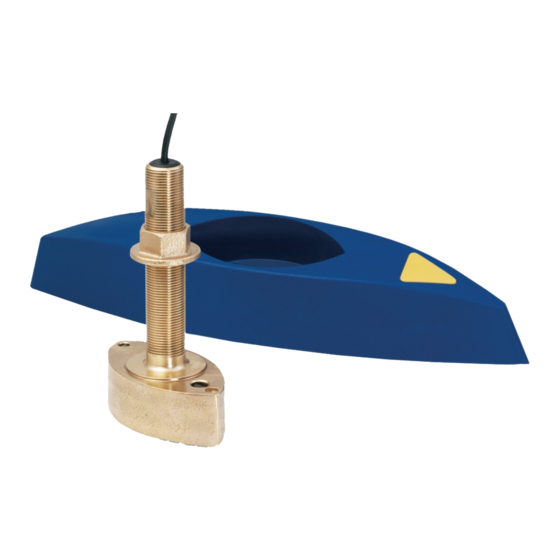Table of Contents
Advertisement
Quick Links
OWNER' S GUIDE & INSTALLATION INSTRUCTIONS
Thru-hull Metal Stem Depth Transducer
Models: B39, B45, B46, B49, B240,
B250, B256, B260, SS505
IMPORTANT :
Please
completely before proceeding with the installation.
These instructions supersede any other instructions in
your instrument manual if they differ.
CAUTION : NEVER USE SOLVENTS
Cleaners, fuels, paint, sealants, and other products may
contain strong solvents, such as acetone, which can attack
many plastics greatly reducing their strength.
Applications
• Bronze housing recommended for fiberglass or wood hulls only.
Caution: Never mount a bronze housing in a metal hull, because
electrolytic corrosion will occur.
• Stainless steel housing is compatible with all hull materials.
• Aluminum or steel hull—Use a stainless steel housing to
prevent electrolytic corrosion.
Caution: Installation requires using a fairing kit to isolate the
stainless steel sensor from a metal hull.
• Caution: Never install a metal housing on a vessel with a
positive ground system.
Tools and Materials
Fairing (mandatory for SS505)
Digital level or bubble level & protractor (installation w/ fairing)
Safety goggles
Dust mask
Band saw or hand saw (installation with a fairing)
Rasp or power tool (installation with a fairing)
Electric drill
Drill bits:
Pilot hole
B39, B49
B45, B46, SS505
B240, B250, B260
B256
Sandpaper
Mild household detergent or weak solvent (alcohol)
Marine sealant
Slip-joint pliers
Zip-ties
Water-based antifouling paint ( mandatory in salt water )
Installation in a cored fiberglass hull: (see page 3)
Drill bit for hull interior:
B39, B49
B45, B46, SS505
B240, B250, B260
B256
Cylinder, wax, tape, and casting epoxy
read
these
instructions
3mm or 1/8"
26mm or 1"
22mm or 7/8"
33mm or 1-5/16"
30mm or 1-3/16"
37mm, 38mm, or 1-1/2"
35mm or 1-3/8"
42mm or 1-5/8"
40mm, 41mm, or 1-5/8"
Record the information found on the cable tag for future reverence.
Part No._________________Date___________Frequency________kHz
B45
Identify Your Model
The model name is printed on the cable tag.
Mounting Location
Acoustic Noise
Acoustic noise is always present and these sound waves can
interfere with the operation of the transducer. Background noise
from sources such as: waves, fish, and other vessels cannot be
controlled. However, carefully selecting the transducer mounting
location can minimize the affect of vessel generated noise from
the propeller(s) and shaft(s), other machinery, and other echo-
sounders. The lower the noise level, the higher the echosounder
gain setting that can be used.
Placement
Choose a location where:
• The water flowing across the hull is smoothest with a minimum
of bubbles and turbulence (especially at high speeds).
• The transducer will be continuously immersed in water.
• The transducer beam is unobstructed by the keel or propeller
shaft(s).
• There is a minimum deadrise angle.
• There is adequate headroom inside the vessel for the height of
the housing and tightening the nut.
Caution : Do not mount the sensor:
Near water intake or discharge openings
Behind strakes, fittings, or hull irregularities
Behind eroding paint (an indication of turbulence)
Boat Types
(see Figure 1)
• Displacement hull powerboat —Locate 1/3 aft LWL and
150–300mm (6–12") off the centerline on the side of the hull
where the propeller is moving downward.
• Planing hull powerboat —Mount well aft, on or near the
centerline, and well inboard of the first set of lifting strakes to
insure that the transducer is in contact with the water at high
speeds. Mount on the side of the hull where the propeller is
moving downward.
Outboard and I/O —Mount just forward of the engine(s).
Inboard —Mount well ahead of the propeller(s) and shaft(s).
Step-hull —Mount just ahead of the first step.
Boat capable of speeds above 25kn (29MPH)—Review
sensor location and operating results of similar boats before
proceeding.
• Fin keel sailboat —Mount to the side of the centerline and
forward of the fin keel 300–600mm (1–2').
• Full keel sailboat —Locate amidships and away from the keel
at the point of minimum deadrise angle.
standard fairing
Advertisement
Table of Contents

Subscribe to Our Youtube Channel
Summary of Contents for Airmar B39
- Page 1 OWNER’ S GUIDE & INSTALLATION INSTRUCTIONS Thru-hull Metal Stem Depth Transducer Record the information found on the cable tag for future reverence. Part No._________________Date___________Frequency________kHz Models: B39, B45, B46, B49, B240, B250, B256, B260, SS505 IMPORTANT : Please read these instructions completely before proceeding with the installation.
- Page 2 Hull Thickness (measured perpendicular to the waterline) Minimum Maximum Maximum pressure waves Model no fairing no fairing with fairing B39, B49 19mm ( ⁄ ") 98mm (3 ⁄ ") 50mm (2") 6mm ( ⁄ ") 92mm (2 ⁄ ") 50mm (2")
- Page 3 4. Apply a 2mm (1/16") thick layer of marine sealant to the surface of the fairing that will contact the hull. band saw cutting table guide 5. Apply a 2mm (1/16") thick layer of marine sealant to the surface of the backing block that will contact the hull Installing deadrise 1.
- Page 4 Checking for Leaks Caution : Completely seal the hull to prevent water seepage into the core. Warning : Never install a thru-hull transducer and leave the boat in 5. Coat a hollow or solid cylinder of the correct diameter with wax the water unchecked for several days.

















Need help?
Do you have a question about the B39 and is the answer not in the manual?
Questions and answers